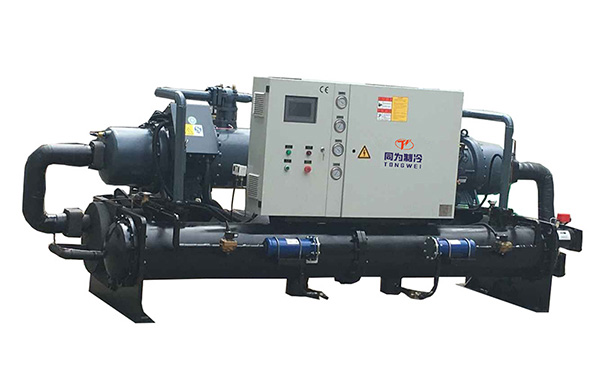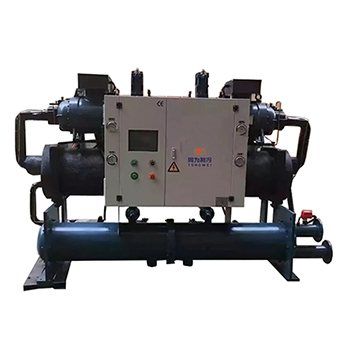1.What is A Concrete Batch Chiller?
A concrete batch chiller is a specialized refrigeration machine used in concrete production plants. Its primary purpose is to cool the water used in the concrete mixing process. This is important because the temperature of the water can significantly impact the setting time and strength development of the concrete.
Concrete Batch Chiller
2.Why Need Chiller for Cooling Concrete Process ?
Concrete cooling is the process of reducing the temperature of concrete to ensure the strength and quality of concrete pouring. There are many disadvantages to using hot concrete, such as unequal density and poor tensile strength. In order to ensure the quality and strength of concrete pouring, the mixture must go through a concrete cooling process to reduce the temperature. Temperature-controlled concrete eliminates the risk of concrete volume expansion due to heat exchange. Heat exchange can also cause the unit to crack, so to avoid this the initial filling temperature should be kept low. However, concrete cooling system specifications vary depending on the application and needs of the project.
3.Application Description
For concrete applications, your thermal load capacity needs to be the single most determining factor in your chiller buying decision. Air cooled chillers are normally installed for concrete cooling applications because of their ease of installation. Sometimes customer installs water cooling towers if the required temperatures are above 20℃. Water cooled chillers can be installed as well with a cooling tower removing the heat from the water cooled condenser.
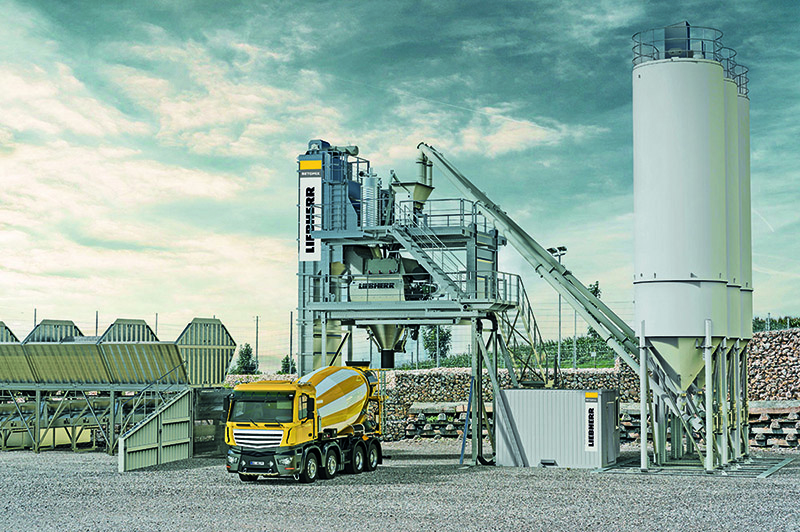
Concrete Batch Processing
4.Concrete Batch Chiller Capacity Is Effected By SeveralFactors
Incoming uncooled water temperature
The warmer your water feed, the fewer yards you can cool with your chiller system.
Ambient Temperature
High ambient lower the chiller’s capacity and make it less efficient. You should always size your chiller based on maximum summer high temperature. If it seldom reaches 100F, but usually stays around 80F, then you could be safe going with a 90degF factor.
Added batch water amount
The larger the volume of the water batch you mix to each concrete yard, the less yards worth of cooled batch water that the process can produce per day.
Blended chilled water
If you use part chilled water, and part unchilled water in your batch process when your current capacity requirement drops below 100%needed, you can save money on operating costs, most notibly energy. A modular chiller system would be ideal in this situation because you could stage in modules as needed per the load requirement. You could have 2nd, 3rd, and 4th units sitting and waiting to be used, saving money all the while. However, when load increases back up to 100%, the 2nd, 3rd, and 4th units kick on automatically to accommodate.
Other Chilled water loads
Some concrete companies use their chilled water loop for multiple purposes(wash out or pre-cooling mixer), then this will reduce the chiller’s daily capacity.
System heat leak
You will gain heat in the system through the batch tank walls, the circulation and supply pumps, and the circulating lines. Most chiller sizing professionals recommend sizing chillers for 20% over theoretical load size to make up for this additional heat gain.
5.What’s the Difference Between Air-cooled & Water-cooled Concrete Batch Chillers?
There are two types of Concrete Batch chiller: one is air-cooled Concrete Batch chiller ,the other is water-cooled Concrete Batch chiller ;
Air-cooled Concrete Batch chillers use ambient air to dissipate heat from the brewing processes. They are energy-efficient, space-saving, and less maintenance that helps save money.
Water-cooled Concrete Batch chillers use water from an external water cooling tower to dissipate heat from the brewing processes. These systems are longer lifespan, Relatively quiet, and more consistent cooling performance than the air-cooled Concrete Batch chiller.
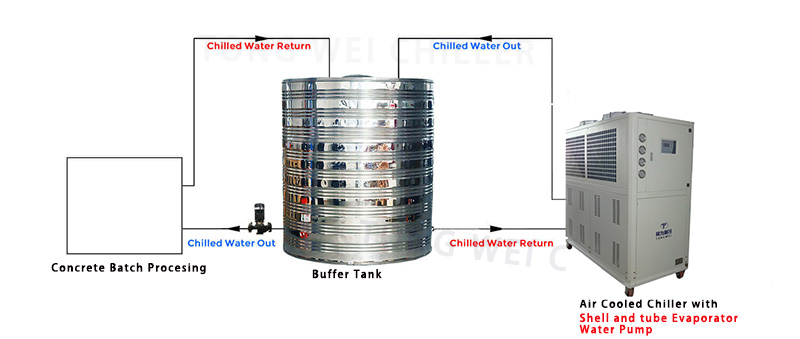
Air-cooled Concrete Batch Chiller Installation Drawing

Water-cooled Concrete Batch Chiller Installation Drawing
Should you choose an air-cooled or water-cooled Concrete Batch chiller? Contact Us for help determining the best solution for you.
6.What is the Difference Between Concrete Batch Scroll Chiller and Concrete BatchScrew Chiller?
Concrete Batch Scroll Chiller Concrete Batch Screw Chiller
▪1/2 HP-60HP(2KW-170KW) Above 60HP(Above 170KW)
▪ Danfoss/Panasonic Scroll Compressor Hanbell/Bitzer Screw compressor
▪Built with water tank and water pump Without water tank and water pump
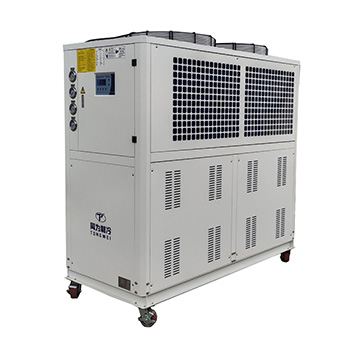
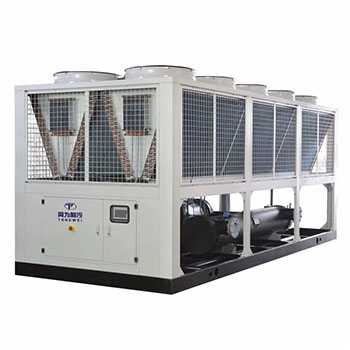
Air-cooled Concrete Batch Scroll Chiller Air-cooled Concrete Batch Screw Chiller
Water-cooled Concrete Batch Scroll Chiller Water-cooled Concrete Batch Screw Chiller
7.What Are The Main Components of Concrete Batch Chillers?
7.1 Compressor
The compressor is the key mover in water chiller because it produces pressure variations to stir the refrigerant around.
From 1/2HP(1/2 Ton) to 60HP(5oTon) Concrete Batch chiller , which is with Panasonic or Danfoss brand Scroll compressor ,
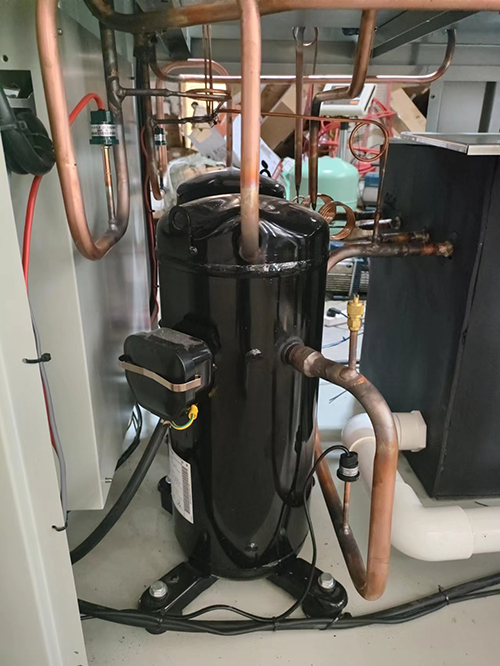 Panasonic Compressor
Panasonic Compressor
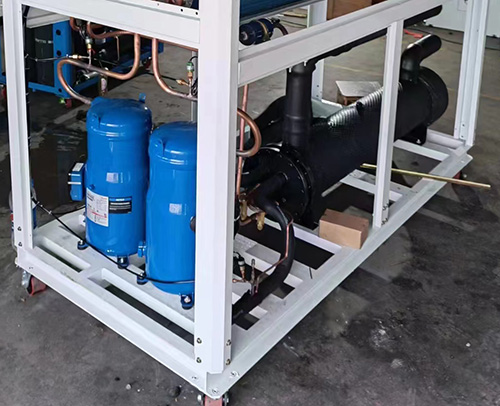
Danfoss Compressor
7.2 Evaporator
The evaporator is a crucial component of air-cooled water chiller, as it is responsible for extracting heat from the liquid being cooled,it is located between the compressor and the expansion valve. There are three types of evaporators : coil in water tank evaporator , shell and tube evaporator, 304SS stainless steel plate type evaporator.
 Coil in SS Water Tank Evaporator
Coil in SS Water Tank Evaporator
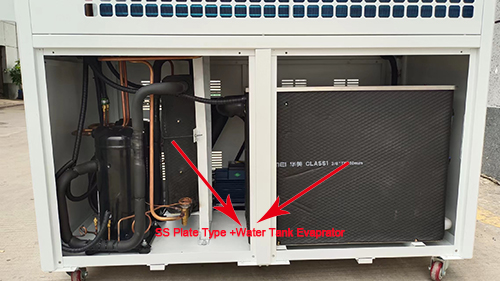
SS Plate Type+ Water Tank Evaporator
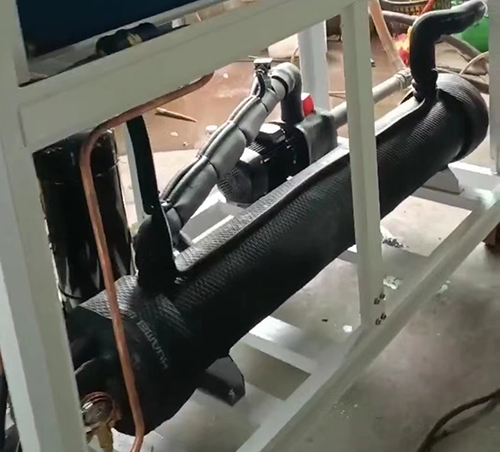 Shell and Tube Evaporator
Shell and Tube Evaporator
7.3 Water Pump
The water pump is designed to increase the pressure and the flow of the chilled water in a closed space.
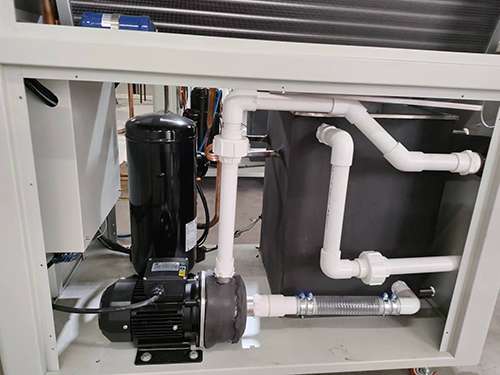
Water Pump
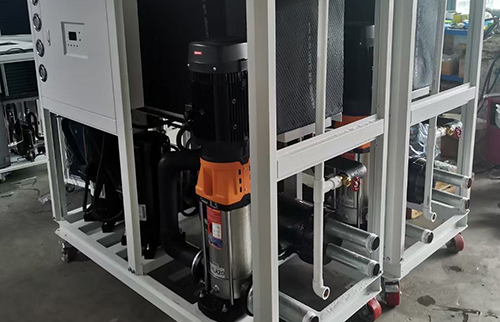
High Pressure Water Pump
7.4 Condenser
The condenser for air-cooled Concrete Batch cooler is equipped with efficient cross-seam fins and female threaded copper tubes for high heat exchange efficiency and good stability.Its function is to cool down the refrigerant steam released from the compressor into a liquid or gas-liquid mixture.
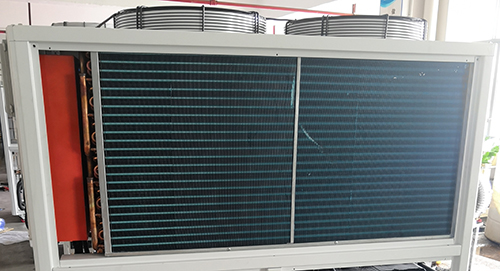
Aluminum fin+fan Condenser for air -cooled Concrete Batch chiller
The condenser for water-cooled Concrete Batch cooler is shell and tube ,with the internal copper tubes employing an outer thread embossing process.This design effectively enhances the heat exchange efficiency between the refrigerant and water during the process. Compared to traditional smooth copper tubes, the outer thread embossing process increases the surface area of the copper tubes, thereby expanding the contact area for heat exchange and improving the thermal conductivity of the condenser. This optimization design allows the condenser of the water-cooled chiller to transfer heat from the refrigerant to the water more rapidly and consistently, enabling the water to carry away the heat.
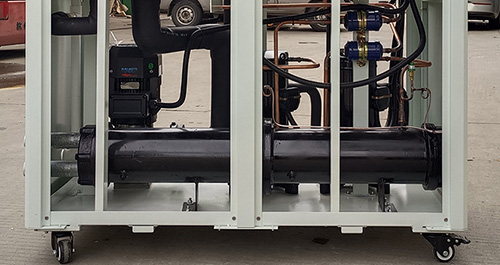
Shell and tube Condenser for water-cooled waterjet cuttting chiller
7.5 Controller Panel
Water chillers use precision digital temperature controller, it RS485 communication port,which can do remote monitoring and control. Simple operation, low failure rate, high safety factor, easy installation.
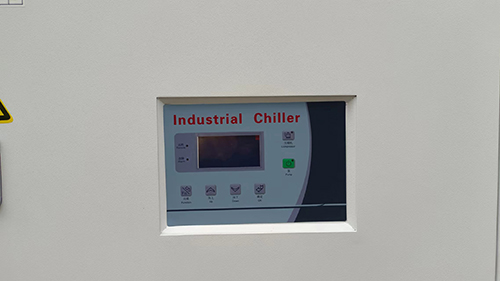
Controller Panel
8.How to Choose Right Chiller for Your Concrete Batch Process?
How to calculate right cooling capacity for your Concrete Batch chillers?
One of the most frequently ask about how we can know the cooling capacity for chillers.
The range of a chiller at which it can discharge heat from a heated fluid is called cooling capacity.
The cooling capacity of a laser Chiller ranges from 1/2KW to 100KW.
Let’s see the below formula.
Cooling Capacity(kw)= Flow Rate(m3/h)*Temp Change(T1-T2)/0.86
Heat Load= C(specific heat)* M(quality output per hour )*Temp Change(T1-T2)
Oversize the chiller by 20% Ideal Size in KW = KW x 1.2
Noted : T1:Incoming Water Temperature (℃) T2:Required Chilled Water Temperature(℃)
For example, what size of chiller is required to cool 5m³ water from 25°c to 15 °c in 1 hour?
Temperature Differential = 25℃-15℃=10℃
Water Flow Rate = 5 m³/hour
Cooling Capacity in KW = 5 x 10 ÷ 0.86 = 58,14 KW
Oversize the chiller = 58.14 x 1.2 = 69.76 KW
69.96kw cooling capacity for chiller is required.
Types of Concrete Batchchiller system?
There are two types of chiller :Air Cooled Concrete Batch Chiller and Water Cooled Concrete Batch Chiller.
Water cooled chiller needs a separated water cooling tower and water cooling pump ,if you don‘t have exsiting water cooling tower,we suggest you use air cooled chiller; But if your ambiemt temperature is very high above 55℃ ,we suggest you use water cooled chiller , as it is easier to dissipate heat for water cooled chiller with water cooling tower.
Whether chillers need built-in Tank or not?
In a chiller system, a tank is usually equipped to buffer the thermal load of the chiller.
But should we choose a built-in type of tank or an external type of tank?
A chiller with a built-in tank is easier to install and can be used simply by connecting a water pipe to your application.
But it has a limited capacity and is not suitable for applications with larger chilled water demands.External tank’s capacity can be customized according to specific needs.
It can buffer a larger heat load, store more chilled water, but the installation will be more troublesome.
If you don‘t have external water tank ,we suggest our chiller built-with water tank ,which is easy for you to install.
Cooling capacity unit conversion?
1 KW=860 kcal/h ;
1 TON=3.517 KW;
1 KW=3412 Btu/h;
9.Contact Us to Learn More About Our Concrete Batch Chillers
We engineer and produce high-quality process chillers compatible with a broad range of industrial processes.
Depending on your needs, we also offer custom chillers to ensure that each client receives the industrial chiller best suited to their unique process.
Request a quote now on our Concrete Batch water chillers or learn about the other air-cooled chillers and water-cooled chillers.

















